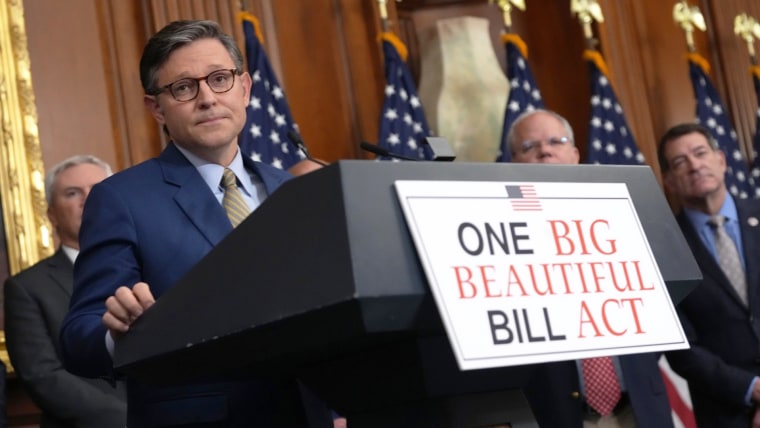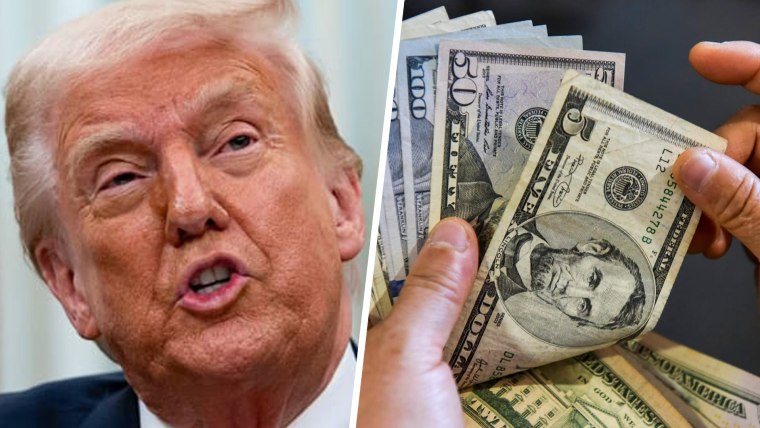Over the past decade, Washington has enacted President Donald Trump’s $1.5 trillion Tax Cuts and Jobs Act (TCJA), a bipartisan $1.7 trillion pandemic-response CARES Act and President Joe Biden’s $1.8 trillion American Rescue Plan. Yet the cost of the House-passed Republican tax cut will likely exceed all three of these expensive laws — combined.
The Congressional Budget Office (CBO) officially scores the GOP tax cuts included in the One Big Beautiful Bill Act as costing $3.8 trillion over the next decade. But the tab rises to $5.3 trillion when removing the deceptive expiration dates included to cover up the bill’s exorbitant long-term cost. Add in the additional tax savings added at the last minute to win more Republican votes, as well as the resulting interest costs, and the true 10-year tax cut cost likely approaches $6.5 trillion. The House bill would offset just $1.3 trillion with savings from programs such as Medicaid, SNAP and student loans — and the Senate is likely to strip many of those offsets.
The tab rises to $5.3 trillion when removing the deceptive expiration dates included to cover up the bill’s exorbitant long-term cost.
The 2017 tax cuts were drafted against a backdrop of $585 billion annual budget deficits. Deficits have since tripled to $1.8 trillion, and Republicans have responded by passing the most expensive legislation since the 1960s. The combination of tax cuts, escalating Social Security and Medicare shortfalls and soaring interest costs will push annual deficits toward $4 trillion within a decade.
Rather than reduce this unfathomable cost, GOP leaders are trying to hide it from voters. To circumvent Congress’ anti-deficit rules, Senate Republicans have suggested simply deleting the CBO score of the TCJA renewals and writing in zero cost. They claim that those original TCJA expiration dates were never real anyway — even as the GOP dutifully adds expiration dates into the new legislation. House Republicans have been seen carrying talking points from Newt Gingrich attacking the CBO for acknowledging that tax relief adds to deficits.
Another stale Washington gimmick has Republicans claiming that tax relief will unleash roughly $13 trillion in additional economic growth over the decade, in turn producing $2.5 trillion of additional tax revenues. However, most of the bill’s cost derives from extending the current TCJA, which leaves unanswered how continuing the same tax policies would suddenly cause economic growth rates to spike to their highest sustained level since the 1990s.
Moreover, the tax legislation undermines any potential economic expansion in several ways. It adds an additional expiration date to its most pro-growth provisions encouraging business investment. Businesses will not undertake expensive and risky long-term investments based on temporary tax provisions, even if those provisions are expected to eventually be renewed. Nor do the bill’s populist giveaways — such as eliminating some taxes on tips, overtime and car loan interest — boost economic growth. Instead, they will clutter the tax code, invite taxpayer gaming and weigh down the economy in more government red ink.
Even the conservative Tax Foundation modeled the tax provisions and found virtually no long-term increase in national income or wages. The economists at the Penn Wharton Budget Model found only minuscule long-term economic benefits. The modest growth effects of tax relief are swallowed by the economic drag of adding tens of trillions of dollars to the long-term federal debt, which in turn diverts national savings away from the investments that would start businesses, create jobs and raise incomes.

Economic growth is, mathematically, the product of labor force growth times worker productivity growth. With the labor force already set to stop growing due to low fertility, baby boomer retirements and Trump’s immigration restrictions, meeting the GOP’s economic targets would require nearly doubling the growth rate of worker productivity. Such an outcome would be quite unlikely even in the absence of a White House-induced trade war devastating key industries and starving the economy of foreign investment. Delivering economic expansion to pay for tax cuts requires more than populist pandering and unrestrained government debt.
Rather than reduce the cost of this budget buster, House Republicans passed their bill by buying off colleagues with even more debt-financed benefits. Coastal state Republicans demanded a last-minute evisceration of the TCJA’s cap on state and local tax (SALT) deductions, with nearly all benefits going to high earners. The bill scales back low-income welfare while providing a $52 billion corporate welfare bailout to farmers, a key GOP constituency. Republicans are correct that escalating spending is the leading long-term deficit driver, yet their refusal to rein in spending growth gives them no business cutting taxes by trillions of dollars.
While Democrats have blasted the cost of the GOP tax legislation, it must be pointed out that their sudden concern over runaway deficits reeks of partisan opportunism rather than principle. After all, Biden signed legislation and executive orders adding nearly $5 trillion to 10-year deficits. Democratic lawmakers refuse to address the Social Security and Medicare shortfalls that will quadruple to $2.2 trillion annually over the decade, and oppose nearly all spending offsets in the GOP bill. They have also endorsed renewing the TCJA for all but the highest-earning 5% of taxpayers, plus an additional trillion-dollar child tax credit expansion and full SALT cap repeal. Senate Democrats this week voted unanimously to stop taxing tips. A $36 trillion federal debt provides enough blame to go around, and both parties must re-evaluate their refusal to confront a debt headed toward $200 trillion over the next three decades.
They can begin by ending the era of trillion-dollar legislation. This month, Moody’s became the latest credit ratings agency to downgrade Washington’s credit rating, and a terrified bond market is pushing up interest rates to levels that could add $500 billion more to annual interest costs. As a fiscal conservative, I prefer low taxes but recognize that tax cuts without spending cuts are just tax deferrals with interest. If extending the 2017 tax relief is truly worth doing — and this includes the expanded child tax credit, higher standard deduction and business investment incentives — then it is also worth paying for.
